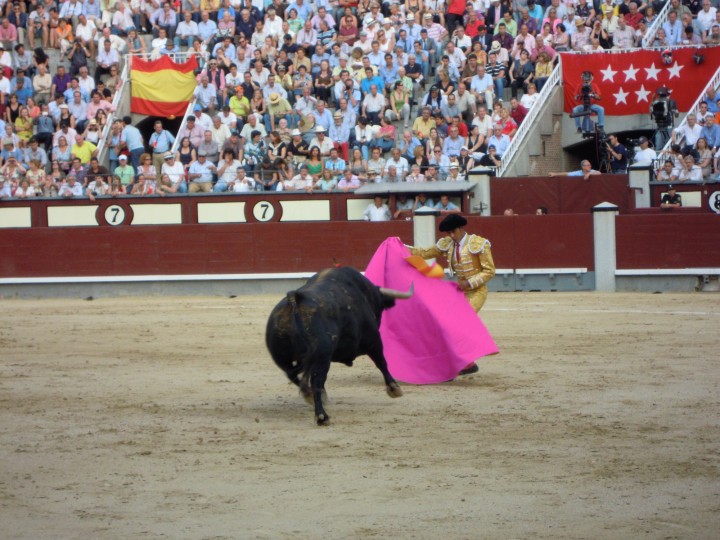
The fighting bull is a special breed very different from the domestic bull. Hemingway described clearly technical details of the physiology and behavior of fighting bulls . Once again he demonstrates his broad and deep knowledge of bullfighting. His book “Death In The Afternoon” is highly recommended for those who are going to attend a bullfight for the first time, but also for anyone who has already attended some of them, in order to deepen and better understand the world of bullfighting. Few writers have so thoroughly written about bullfights as Hemingway wrote
“The fighting bull is to the domestic bull as the wolf is to the dog. A domestic bull may be evil tempered and vicious as a dog may be mean and dangerous, but he will never have the speed, the quality of muscle and sinew and the peculiar build of the fighting bull any more than the dog will have the sinews of the wolf, his cunning and his width of jaw. Bulls for the ring are wild animals. They are bred from strain that comes down in direct descent from the wild bulls that ranged over the Peninsula and they are bred on ranches with thousands of acres of range where they live as free ranging animals. The contacts with men of the bulls that are to appear in the ring are held to the absolute minimum.
The physical characteristics of the fighting bull are its thick and very strong hide with glossy pelt, small head, but wide forehead; strength and shape of horns, which curve forward; short, thick neck with the great hump of muscle which erects when the bull is angry; wide shoulders, very small hooves and length and slenderness of tail. The female of the fighting bull is not as heavily built as the male; has a smaller head; shorter and thinner horns; a longer neck, a less pronounced dewlap under the jaw; is not as wide through the chest, and has no visible udder. I have frequently seen these cows in the ring in the amateur fights in Pamplona charging like bulls, tossing the amateurs about and they were invariably spoken of by the visiting foreigners as steers, since they showed no visible signs of their cowhood and gave no evidence of femininity. It is in the female of the fighting bull that you see most plainly the difference between the savage and domestic animal.
One of the things one hears oftenest about bullfighting is the statement that a cow is much more dangerous when charging than a bull as the bull shuts his eyes while a cow keeps hers open. I do not know who started this, but there is no truth in it. The females that are used in amateur fights almost invariably make for the man rather than the cape, cut in on him rather than charge straight and will often single out one particular man or boy and pursue him through a crowd of half a hundred, but they do this not because of any innate superior intelligence in the female, as Virginia Woolf might suppose, but because female calves, since they are never to appear in the ring in normal fights and since there is no objection to their becoming completely educated in all the phases of bullfighting, are used exclusively for the bullfighters to train on with cape and muleta. Either a bull calf or a cow calf, if passed a few times with cape or muleta, learns all about it, remembers, and, if it is a bull, becomes consequently useless for a formal bullfight where everything is built on the basis of this being the bull’s first encounter with a dismounted man. If the bull is unfamiliar with cape or muleta and charges straight, the man can create the danger himself by working as close to the bull’s charge as possible and will be able to attempt a variety of passes, selecting them himself and arranging them in an emotional sequence rather than being forced into them as defensive measures. If the bull has been fought before, he will cut in constantly on the man, will chop with his horns into the cloth looking for the man, and will create all the danger himself, putting the man constantly in retreat and on the defensive and making any clarity of passes or brilliance of fight impossible.
The bullfight has been so developed and organized that the bull has just time enough, coming into the ring completely unfamiliar with dismounted men, to learn to distrust all their artifices and reach the summit of his danger at the moment of killing. The bull learns so rapidly in the ring that if the bullfight drags, is badly done, or is prolonged an extra ten minutes he becomes almost unkillable by the means prescribed in the rules of the spectacle. It is for this reason that bullfighters always practice and train with female calves which, after a few sessions, become so educated, the fighters say, that they can talk Greek and Latin. After this education, they are released in the ring for the amateurs; sometimes with naked horns, sometimes with the points covered with a leather ball, they come in as fast and lithe as deer to practice on the amateur capemen and aspirant bullfighters of all sorts in the capeas; to toss, rip, gore, pursue and inspire with terror these amateurs until, when the vacas tire, steers are let into the ring to take them out to rest in the corrals until their next appearance. The fighting cows, or vaquillas, seem to enjoy these appearances. They are not goaded, no divisa is placed in their shoulders, they are not irritated to make them charge and they seem to enjoy charging and tossing as much as a fighting cock does fighting. Of course they receive no punishment while the bull’s bravery is judged by the manner in which he behaves under punishment.
The manoeuvring of fighting bulls is made possible by the operation of the herd instinct which makes it possible to drive bulls in groups of six or more where one bull, if detached from the herd, will charge instantly and repeatedly anything, man, horse, or any moving object, vehicle or otherwise, until he is killed; and by the use of trained steers or cabestros to herd and decoy the fighting bulls as wild elephants are caught and herded by elephants which have been tamed. It is one of the most interesting of all phases of bullfighting to see the steers work in the operations of loading, separating, putting the bulls into the runways that lead to the shipping cages and in all the many operations connected with the raising, transporting and unloading of fighting bulls.”
Ernst Hemingway, “Death In The Afternoon”
THE TROPHIES
Once the bull is dead, the audience, by applause and whistles,
judges the matador´s performance and, as such, influences the
final ruling from the president.
Two ears and tail
This is the highest trophy awarded in bullfighting in the
category of first class. The president must take out the white
kerchief three times before the bull is dragged away.
Two ears
The trophies that ensure that the bullfighter will be carried on
the public´s shoulders through the main door of the bullring.
The president must take out the white kerchief three times
before the bull is dragged away.
One ear
The audience decides if the bullfighter deserves the prize. The
president must grant the bull´s ear to the bullfighter if the
majority of the audience shows their white kerchief.
Greeting
This is the consolation prize given, when despite the
bullfighter´s best efforts, things don´t come out the way he
had intends.
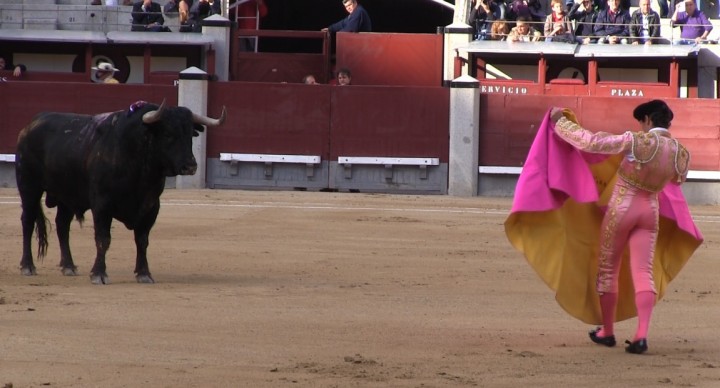
The Opera Carmen And Bullfighting
First peformed on March 3rd , 1875,“Carmen” is the only popular opera that prominently features bullfighting. The opera’s “Toreador Song,” describes a bullfight, and the opera’s final scene opens with the procession of picadores, banderilleros, and finally the matador (Escamillo) into the arena.
Carmen is an opera in 4 acts composed by Georges Bizet between 1873 and 1875 , written by Heri Meilhac and Ludovic Halévy and based on the novel “Carmen” by Prosper Mérimée. Nowadays Carmen is one of the most popular and frequently perfomed operas.
The action set in southern Spain and tells the story of Don José , a soldier seduced by the gypsy Carmen. When he deserts from his military duties , he found out that Carmen loves Escamillo, a famous bullfighter.. Desperate, in a fit of jealousy José Kills Escamillo
This is a Litograph of the Carmen’s premier perfomance by Pierre Auguste Lamy (1875)
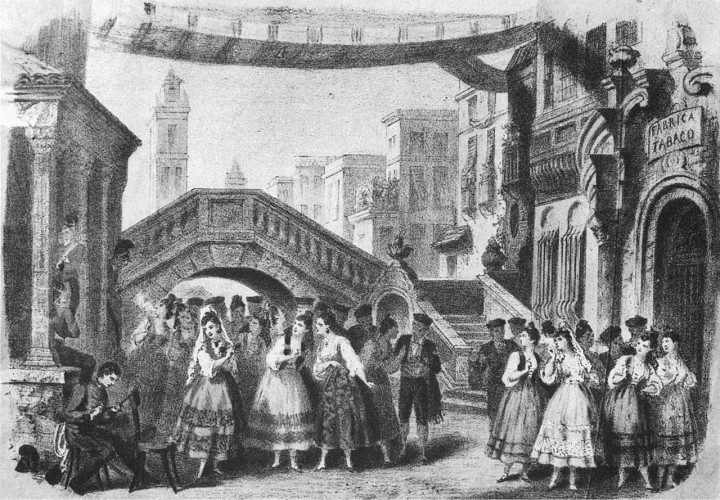
“Fiesta Nacional” By Manuel Machado
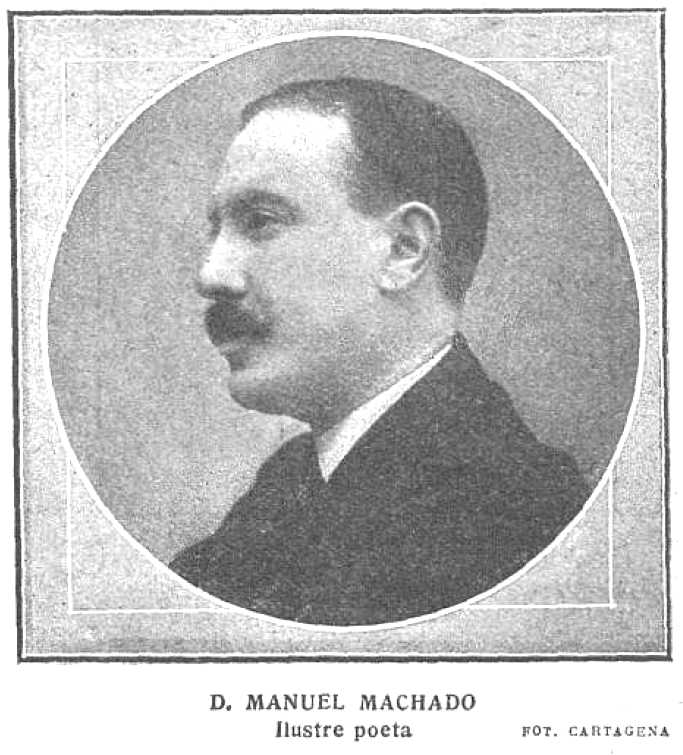 Manuel Machado Ruiz , born in Sevilla on August 29th and dead in Madrid on January 19th, was an important spanish poet and playwright, and brother of the famoes poet Antonio Machado. He studied at the Institución Libre de Enseñanza of Madrid, run by his grandfather’s friend Giner De Los Rios. Afterwards he studied Philosofy at the University of Sevilla and In 1902 Manuel published “Alma” , his first book.
Manuel Machado Ruiz , born in Sevilla on August 29th and dead in Madrid on January 19th, was an important spanish poet and playwright, and brother of the famoes poet Antonio Machado. He studied at the Institución Libre de Enseñanza of Madrid, run by his grandfather’s friend Giner De Los Rios. Afterwards he studied Philosofy at the University of Sevilla and In 1902 Manuel published “Alma” , his first book.
In 1906 Manuel Machado wrote “Fiesta Nacional”, one of the most beautiful poems about bullfighting:
Una nota de clarín
desgarrada,
penetrante,
rompe el aire con vibrante
puñalada.
Ronco toque de timbal.
Salta el toro
en la arena. Bufa, ruge…
Roto cruje
un capote de percal…
Acomete rebramando,
derribando
a caballo y caballero.
Da principio
el primero
espectáculo español.
La hermosa fiesta bravía
de terror y de alegría
de este viejo pueblo fiero…
Oro, seda, sangre y sol.
Goya And The Stage of Varas
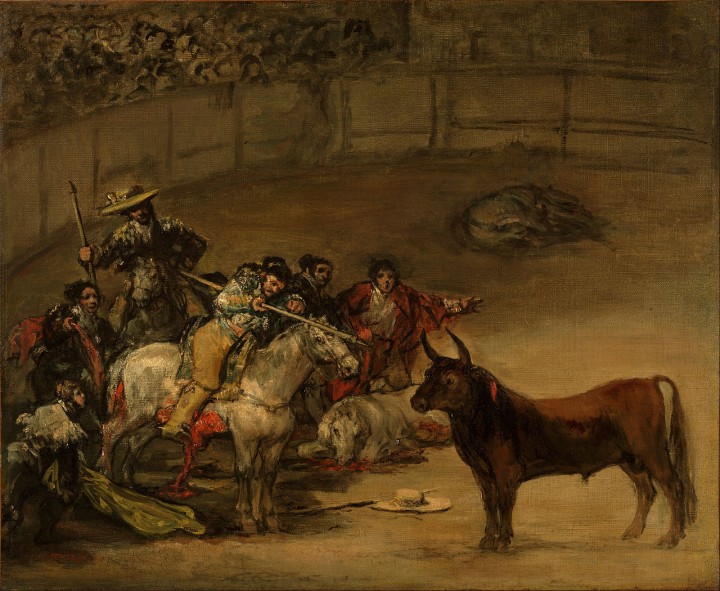 Goya produced many images of bullfights. He painted this canvas in 1824 when he was 78 years old when he was living in France. It is an oil on Canvas, 49,80 x 70,80 cm. The bull is ready for charge against the Picador. In background there is dead horse riminding us that at the time horses faced the bull without protective shells.
Goya produced many images of bullfights. He painted this canvas in 1824 when he was 78 years old when he was living in France. It is an oil on Canvas, 49,80 x 70,80 cm. The bull is ready for charge against the Picador. In background there is dead horse riminding us that at the time horses faced the bull without protective shells.
In 1816 Francisco de Goya published Tauromaquia, 33 engravings about bullfighting. They represents teh evolution of bullfighting from its origin to the begining of the XIX century and ilustrates huge achievements of famous bullfighters as Pedro Romero, Ceballos and Pepe Illo.
Francisco de Goya y Lucientes was born in Fuentetodos, a town in the province of Zaragoza on March 30th 1746. Between 1767 and 1771 travelled to France and Italy and afterwads started to make the first engravings inspirede by some paintings by Velazquez.
In 1785 Goya became director of the de Department of painting at the San Fernando’s Academy and in 1786 official spanish king’s painter.
In 1792 he became deaf and started to have hallucinations and extrange visions. Nonetheless he painted the dome of the real Chapel of San Antonio De La Florida in Madrid and a year after he made de egranving’s collection “Los Caprichos”.
Goya was shocked by the terrible Napoleonic invasion in 1808 by which he was inspired to paint “ Los fusilamientos del 3 de Mayo” and La Carga de los Mamelucos” and to print “Los Desastres De La Guerra”. In 1824 he went to Burdeos and printed the series of 4 lithographies “ Los Toros de Burdeos”. On April 16th 1826 he died in Burdeos at the age of 82
VALENCIA: FERIA DE FALLAS
 Between the 10 of March and the 13 of May 2017 will be celebrated in Valencia the following bullfights:
Between the 10 of March and the 13 of May 2017 will be celebrated in Valencia the following bullfights:
Friday March 10th. Erales de Aida Jovani para Miguel Senent “Miguelito” (Escuela de Tauromaquia de Valencia), Ramón Serrano (Escuela de Tauromaquia de Murcia) y Álvaro Passalacqua (Escuela de Tauromaquia de Málaga).
Saturday 11th: Toros de Alcurrucén para Juan Bautista, Fortes y Álvaro Lorenzo.
Sunday 12th: Toros de Fuente Ymbro para Juan José Padilla, Curro Díaz y Manuel Escribano.
Monday 13th: Novillos de El Parralejo para Diego Carretero, Leo Valadez y Jorge Rico.
Tuesday14th: Novillos de José Vázquez para Cristian Climent, Andy Younes y Marcos.
Wendsday 15th: Toros de Jandilla y Vegahermosa para David Mora, Paco Ureña y Javier Jiménez.
Thursday 16th: Toros de Victoriano del Río y Toros de Cortés para Sebastián Castella, Miguel Ángel Perera y Román.
Friday 17th: Toros de Núñez del Cuvillo para El Fandi, José María Manzanares y Roca Rey.
Saturday 18th: Toros de Juan Pedro Domecq para Enrique Ponce, Cayetano y Ginés Marín.
Sunday 19th: Matinal. Toros de Fermín Bohórquez para Diego Ventura, Manuel Manzanares y Lea Vicens.
Sunday 19th : Toros de Garcigrande y Domingo Hernández para El Juli, Alejandro Talavante y López Simón.
Además, también se ha dado a conocer la novillada que tendrá lugar en el marco de la
Feria de la Virgen de los Desamparados
Saturday, 13thMay: Novillos de Sánchez Herrero para Fernando Beltrán, Alfonso Cadaval y Carlos Ochoa.
THE CLEARING
 When bullfights took place in plazas, royal civil servants had to clear the
When bullfights took place in plazas, royal civil servants had to clear the
people from the plazas before letting out the first bull. But nowadays
when a bullfight takes place, in bullrings, clearing out the ring is a mere
formality. In remembrance of this tradition today, two “Alguaciles” on
horseback (persons responsible for opening the bull pen at the beginning of a bullfight) are dressed in the old style clothing from the time of Felipe
IV. Their job is to go around the ring to make sure that it is devoid of
people.
Once the “despejo” is finished, the “Alguaciles” greet the president,
nodding their heads and taking off their hats. Other duties of the “Alguaciles” include picking up the key from the bullpen, conveying and executing orders from the President, and giving out prizes to the bullfighters.
The Stage of “Banderillas”
What is the Stage of “Banderillas”?
One of the things that most impresses those who attend a bullfight for the first time is the stage of banderillas ( Tercio de Banderillas). It is brief, since it usually does not last more than five minutes, but very intense, because the man faces the bull without the protection of the cape or the muleta. It can also become an aesthetic experience, if the banderillero does his job well and the bull charges fiercely. However, it is not easy to understand its meaning and sense within the framework of the entire bullfight.
The main objective of the Stage of “Banderillas” is to prepare the bull for the next stage: The Stage of Muleta (Suerte de Muleta).
Three bullfighters’ assistants or sometimes the bullfighter him or herself jab the bull’s back with three pairs of “Banderillas”. The bull feels a sharp pain when the “Banderillas” have pierced its back.
In the chapter X of “Death In The Afternoon”, Hemingway wrote about the Stage of “Banderillas”, Providing very interesting data to better understand this important part of the Bullfight.
“Act two is that of the banderillas. These are pairs of sticks about a yard long, seventy centimetres to be exact, with a harpoon-shaped steel point four centimetres long at one end. They are supposed to be placed, two at a time, in the humped muscle at the top of the bull’s neck as he charges the man who holds them. They are designed to complete the work of slowing up the bull and regulating the carriage of his head which has been begun by the picadors: so that his attack will be slower, but surer and better directed. Four pair of banderillas are usually put in. If they are placed by the banderilleros or peones they must be placed, above all other considerations, quickly and in the proper position. If the matador himself places them he may indulge in a preparation which is usually accompanied by music. This is the most picturesque part of the bullfight and the part most spectators care for the most when first seeing fights. The mission of the banderilleros is not only to force the bull by hooking to tire his neck muscles and carry his head lower but also, by placing them at one side or another, to correct a tendency to hook to that side. The entire act of the banderillas should not take more than five minutes. If it is prolonged the bull becomes discomposed and the fight loses the tempo it must keep, and if the bull is an uncertain and dangerous one he has too many opportunities to see and charge men unarmed with any lure, and so develops a tendency to search for the man, the bundle, as the Spanish call him, behind the cloth when the matador comes out for the last act with the sword and muleta.”

El Salto De La Garrocha
FRANCISCO DE GOYA was 70 years old when he made “TAUROMAQUIA”, a series of 33 engravings about bullfighting scenes. He used techniques of etching and aquatint. Since he was Young he liked bullfights very much. Some of these prints were made to ilustrate the text by Moratín “Historical Letter about the origins and progress of bullfights in Spain, publised in 1777.
This amazing engraving by Goya represents El Salto De La Garrocha ( The Garrocha’s Jumping).
The Stage of Varas is the phase in which the bull is lanced by the Picador in order to weaken it and prepare it for the Stage of Muleta. The Picador uses the Garrocha ,a lance with a 16 cm steel tip.
But The Garrocha has been used in the past differently.
El Salto de la Garrocha ( The Garrocha’s Jumping) consists in the fact that, the bullfighter goes whith the Garrocha to the center of the Arena and calls the bull; and When the bull charges and gets close to the bullfighter, he leans on the Garrocha and jumps over the bull.

PRELIMINARIES: A BRIEF STUDY OF THE BULL
As bullring’s staff show a banner with the name and weight of the first bull on it, one of the “Alguacilillos” gives the key to the bullpens to the “Chulo de Toriles”
(the person in charge of opening the door from which the bull comes out into the
ring). Once the “Areneros” have cleaned the ring and everything is in order, the
president taking out the white kerchief, orders the first bull to be released.
After a short sound of the bugles, the door of the bullpen is opened and the bull goes out into the arena. Right away bullfighter’s assistants dragged the cape in front of the bull’s face and it reacts runing towards and charging against the red cloth. The bullfighter, focused on the scene, observes very carefully how the bull moves and follows the moving layer. This way he gets important information about the beast, for instance, if it sees well with both eyes or which horn it prefers to charge with. Knowing these details , the bullfighter can elaborate in advance the best strategy to fight with the bull. This brief study of the bull usually does not last more than two or three minutes, but it can be determinant for the course of the bullfight. The bullfighter must be very concentrated in order to get an accurate idea of what kind of bull has to fight with.

